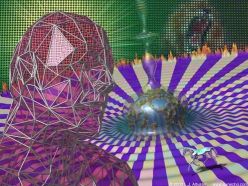It is true enough to say that Gurdjieff’s system of ideas is complex and all-encompassing, but one must immediately add that their formulation is designed to point man toward a central and simple power of apprehension which Gurdjieff taught is merely latent within the human mind and which is the only power by which man can actually understand himself in relation to the universe. In this sense, the distinction between doctrine and method, which is fairly clear in most of the older spiritual traditions, does not yet entirely obtain in the Gurdjieff teaching. The formulations of the ideas are themselves meant to have a special action on the sense of self and may therefore be regarded as part of the practical method. This characteristic of the Gurdjieff teaching reflects what Gurdjieff perceived as the center of gravity of modern man’s subjectivity—the fact that modern civilization is lopsidedly oriented around the thinking function. Modern man’s illusory feeling of “I” is built up around his thoughts and therefore, in accordance with the level of the pupil, the ideas themselves are meant to affect this false sense of self. For Gurdjieff the deeply penetrating influence of scientific thought in modern life was not something merely to be deplored, but to be understood as the channel through which the eternal Truth must first find its way toward the human heart.
Man, Gurdjieff taught, is an undeveloped creation. He is not really man, considered as a cosmically unique being whose intelligence and power of action mirror the energies of the source of life itself. On the contrary, man as we encounter him is an automaton. His thoughts, feelings, and deeds are little more than mechanical reactions to external and internal stimuli. He cannot do anything. In and around him, everything happens without the participation of his own authentic consciousness. But human beings are ignorant of this state of affairs because of the pervasive influence of culture and education, which engrave in them the illusion of autonomous conscious selves. In short, man is asleep. There is no authentic I am in his presence, but only an egoism which masquerades as the authentic self, and whose machinations poorly imitate the normal human functions of thought, feeling, and will.
Many factors reinforce this sleep. Each of the reactions that proceed in one’s presence is accompanied by a deceptive sense of I—man is many I’s, each imagining itself to be the whole, and each buffered off from awareness of the others. Each of these many I’s represents a process whereby the subtle energy of consciousness is absorbed and degraded, a process that Gurdjieff termed “identification.” Man identifies—that is, squanders his conscious energy, with every passing thought, impulse, and sensation. This state of affairs takes the form of a continuous self-deception and a continuous procession of egoistic emotions, such as anger, self-pity, sentimentality, and fear which are of such a pervasively painful nature that man is constantly driven to ameliorate this condition through the endless pursuit of social recognition, sensory pleasure, or the vague and unrealizable goal of “happiness.”
According to Gurdjieff, the human condition cannot be understood apart from considering humanity within the function of organic life on earth. The human being is constructed to transform energies of a specific nature, and neither his potential inner development nor his present actual predicament is understandable apart from this function. Thus, in the teaching of Gurdjieff, psychology is inextricably connected with cosmology and metaphysics and even, in a certain sense, biology. The diagram known as “the Ray of Creation” provides one of the conceptual keys to approaching this interconnection between humanity and the universal order, and as such invites repeated study from a variety of angles and stages of understanding.
In this diagram, the fundamental data about the universe gathered by science, and specifically the principal cosmic entities that modern astronomical observation has marked out, are arranged in a manner coherent with ancient metaphysical principles about humanity’s actual place in the scheme of creation. The reader is referred to chapters 5, 7, and 9 in In Search of the Miraculous for an explanation of this diagram, but the point to be emphasized here is that, at the deepest level, the human mind and heart are enmeshed in a concatenation of causal influences of enormous scale and design. A study of the Ray of Creation makes it clear that the aspects of human nature through which one typically attempts to improve one’s lot are without any force whatever within the network of universal influences that act upon man on earth. In this consists man’s fundamental illusion, an illusion only intensified by the technological achievements of modern science. Man is simply unable to draw upon the conscious energies passing through him, which in the cosmic scheme, are those possessing the actual power of causal efficacy. Man does not and cannot participate consciously in the great universal order, but instead is tossed about en masse for purposes limited to the functions of organic life on earth as a whole. Even in this relatively limited sphere—limited, that is, when compared to man’s latent destiny—mankind has become progressively incapable of fulfilling its function, a point that Gurdjieff strongly emphasized in his own writings. This aspect of the Ray of Creation—namely, that the “fate of the earth” is somehow bound up with the possibility of the inner evolution of individual men and women—resonates with the contemporary sense of impending planetary disasters.
This document originates from:


by Jacob Needleman